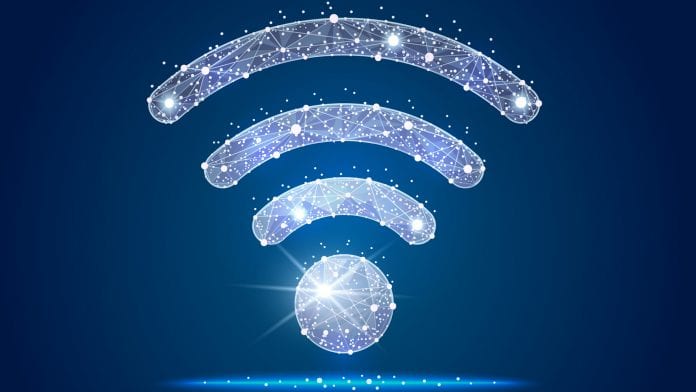
Professor Haruichi Kanaya presents a new renewable energy format suitable for IoT medical monitoring solutions.
Monitoring vital information such as body temperature is critical for controlling the onset of infection as we begin to reach a ‘new normal’ in the era of COVID-19. In many hospitals, companies, and universities or schools, medical personnel, patients, office workers and students are obliged to measure their body temperature daily.
To measure this vital information without disrupting their day-to-day routines, anyone who is compelled to submit regular temperature updates may wear an Internet of Things (IoT) device such as a sensor equipped with a wireless transmitter which transmits the pertinent data to their smartphone or PC in real time. However, as IoT devices are battery powered, they must be recharged or replaced.
Energy harvesting technologies, such as solar cells and wind turbines, collect energy from the nature around us and convert it into electricity. As long as energy is present in the surrounding environment, energy harvesting allows the system to run in place of batteries. We believe that the clean, renewable energy generated through these methods will help solve future energy problems; however, some issues remain in place: with a solar cell, for example, it is difficult to obtain a consistent flow of electricity as the cell can only generate power during the day.
On the other hand, the radio waves used for broadcasting and wireless telecommunication are transmitted from broadcasting or base stations day and night. If these waves can be converted to electricity, it could be effective as constant electric power1. For example, when operating a sensor and communication circuit with a battery, a DC voltage of 1.5V to 3V is required.
However, these radio waves are weak because their output power is strictly restricted by law, and it has been challenging to obtain sufficiently high voltage until now. Therefore, we have developed a new circuit which amplifies radio waves and converts them to a direct electric current using impedance matching circuits and stacked rectifying circuits.
We designed and fabricated the planar wireless energy harvesting circuit with the antenna rectifier on the printed circuit board and connected the temperature, humidity and communication distance sensor to the Bluetooth low energy (BLE) module. Using this device, we were able to measure the body’s surface temperature and transmit the data to a laptop PC every five minutes without a battery.
Antenna design
The operating frequency is set to 920MHz. This is an ultra-high frequency (UHF); and falls within a frequency band which is already used in many applications such as radio frequency identification (RFID or IC tag), automated checkout and inventory control. Transmission power up to 250mW (24dBm) is possible without a licence. Fig. 1 shows a layout of a planar antenna, which is realised on a printed circuit board. An antenna was fabricated by patterning on the top metal surface and the gain of the antenna is 3dBi. The size of the antenna is 70mm x 45 mm.
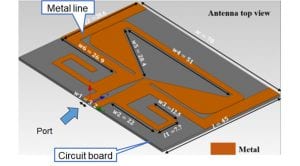
Boosting and rectifier circuit
An impedance matching circuit is a circuit which amplifies the transmitted radio frequency voltage, which is realised by using inductors and capacitors. The rectifier circuit that converts AC signals (radio waves) into direct current is composed of a diode and a capacitor2.
In high-frequency circuits, because the thickness, width and length of the metal lines on the circuit board affect the circuit characteristics, all metal lines are modelled using electromagnetic field analysis. Fig. 2 shows a photograph of the prototype energy harvesting circuit with an integrated antenna. The three sets of the eight-stage stacked rectifier on the top and both sides boost the weak electromagnetic waves. The size is 80mm x 100mm. As the circuit is realised on the top of the printed circuit board, it can be stored in a credit card or name tag in the future.
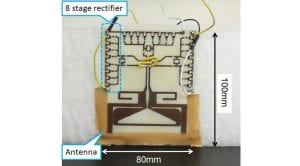
Measurement and results
Fig. 3 shows a photograph of the experimental setup. The distance from the transmitting antenna to the energy harvester is 7m. The output power is 22dBm (158mW), which is within the confines of the law.
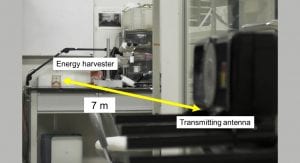
Fig. 4 shows a photograph of the process of temperature measurement on the body surface. Surface temperature is transmitted to the laptop PC by BLE every five minutes. After attaching the sensor to the body surface, measured temperature has risen, and the measurement is continued without batteries. The essential parts of the planar antenna and boost/rectifier circuit for converting the weak electromagnetic waves used for telecommunication into electricity have been completed from these results.
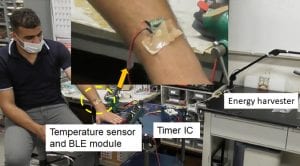
Conclusions
We were able to establish the basis of a monitoring system that transfers vital information such as body temperature to PCs or smartphones without the need for batteries.
These results are the first step toward the realisation of new renewable energy. In the future, if it is possible to generate electricity from electromagnetic waves easily, it can be expected to create a large amount of electric power in combination with natural energy in each situation. For example, we can use electromagnetic waves at night or during cloudy days and augment the energy they produce with that generated by solar cells when the sun is out. It is a future that does not require batteries and is free from charging; and will lead to the establishment of a new normal.
Biography
Dr Haruichi Kanaya was born in Yamaguchi, Japan, in 1967. He received a Bachelor of Science degree in Physics from Yamaguchi University. In 1994, he became a Research Fellow (PD) of Japan Society for the Promotion of Science. In 1998, he was a visiting scholar at the Massachusetts Institute of Technology (MIT), USA. He is currently engaged in the study and design of RF CMOS System LSI and superconducting microwave devices, as a Professor in the Department of Electronics, Graduate School of Information Science and Electrical Engineering, Kyushu University. Dr Kanaya is a senior member of the Institute of Electronics, Information and Communication Engineers (IEICE) and the Institute of Electrical and Electronics Engineers (IEEE).
Funding
• The Cabinet Office (CAO) Cross-ministerial Strategic Innovation Promotion Programme (SIP), ‘An intelligent knowledge processing infrastructure, integrating physical and virtual domains’ (funding agency: NEDO);
• A-STEP, JSPS;
• The Telecommunications Advancement Foundation;
• Grant-in-Aid for Scientific Research, Japan Society for the Promotion of Science (JSPS).
• KAKENHI (18K04146), MEXT; and
• READYFOR, Inc (crowdfunding)
Collaborations
• ALSENS Inc; and
• SEIKO Electric Co. LTD.
Team members
• Dr Mohamed M Mansour (PhD Fellow), Kyushu University;
• Mr Syuya Yamamoto (Master’s course student), Kyushu University; and
• Mr Shota Torigoe (Master’s course student), Kyushu University.
References
1 H Kanaya, S Tsukamoto, T Hirabaru, D Kanemoto, R Pokharel, K Yoshida. ‘Energy harvesting circuit on a one-sided directional flexible antenna’. IEEE Microwave and Wireless Components Letters, vol. 23, no. 3, pp 164–166, March 2013.
2 M Mansour, X Le Polozec, H Kanaya. ‘Enhanced broadband RF differential rectifier integrated with archimedean spiral antenna for wireless energy harvesting applications’. Sensors 19 (3), 655, 2019.
Professor Haruichi Kanaya
+81 92 802 3746
kanaya@ed.kyushu-u.ac.jp
http://yossvr0.ed.kyushu-u.ac.jp
This article is from issue 15 of Health Europa. Click here to get your free subscription today.
























